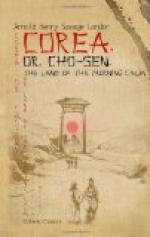On the night in question, that was practically what happened. Two houses adjoining one another were burnt out, and, the roofs having crumbled away, the long thick beams alone were left in position, supported at either end by the stone walls of the houses, and still blazing away, and placing the neighbouring houses that had thatched roofs in considerable danger.
I was much amused at a Corean, the owner of one of these latter, who, to save his thatched shanty from the flames, pulled it down. His efforts in this direction were, however, of no avail in the end; for the inflammable materials, having been left in the roadway in the immediate neighbourhood of the conflagration, caught fire and were consumed.
The King had been informed of the occurrence, a very rare one in Seoul, and had immediately dispatched a hundred soldiers to—look on, and to help, if necessary. Some individuals, too, more enterprising than the rest, exerted themselves to draw water from the neighbouring wells; but, by the time they had returned to the spot where it was required, it was converted into one big lump of ice. Finally, recourse was had to the old Corean method of putting out the fire, namely, by breaking the beam, not an easy job by any means, and then, when it had fallen, covering it with earth.
The soldiers had brought with them—conceive what? A ship’s anchor! To this anchor was tied a long thick rope. Their object was, of course, to fix the anchor to the burning beam, which being done, fifty, sixty or more strong men could pull the rope, and so break the beam in two and cause it to fall. Well and good; but where was the warrior to be found who would volunteer to go up on the summit of the frail mud-and-stone wall and hook the anchor in the right place The affair now wore a different aspect altogether, no one being willing to go; whereupon the officer in command reprimanded his troops for their lack of pluck.
Among the soldiers, however, there was one man, stout and good-natured looking; and he, being taken aback apparently by the officer’s remarks, at once asserted that he, at all events, was not lacking in courage, and would go. For him, accordingly, a ladder was provided, and up he went, carrying the anchor on his back. When he reached the last step, he stopped and, turning to harangue the people, told them that the beam was a solid one, and that a very




